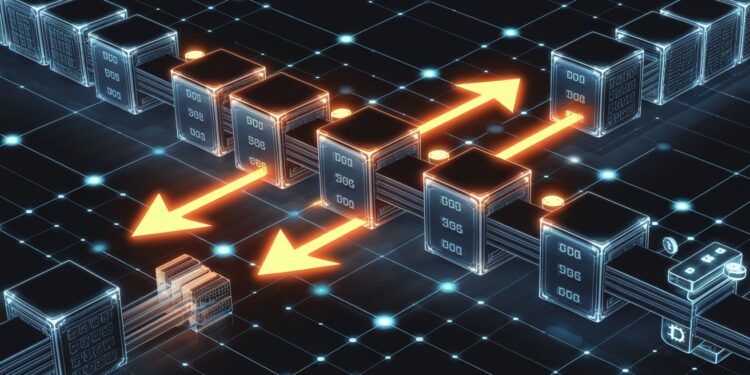Have you ever wondered why some blockchain transactions take so long? The answer often lies in scalability. Blockchain technology promises a lot, but one big hurdle is how well it handles lots of transactions at once. Sharding might just be the solution we’ve all been waiting for.
The future of blockchain depends on its ability to scale. This article explores blockchain sharding, looking at how it works, what it offers, and how it can solve some of the biggest problems. Let’s jump in!
Understanding the Blockchain Scalability Problem
Blockchain technology faces a big challenge: scalability. As more people use blockchains, the systems can slow down. This is because of the way traditional blockchains handle information.
The Bottleneck of Traditional Blockchains
In a traditional blockchain, every computer or “node” has to process every transaction. This means if there are a lot of transactions, each node has to work harder. That’s a bottleneck, like a traffic jam on the information highway. This limitation impacts how quickly the system can confirm transactions.
The Impact on Transaction Speed and Fees
Scalability problems lead to slower speeds and higher costs. When the blockchain gets busy, transactions take longer to confirm. Think of it like waiting in a long line at a store. To skip the line, you might pay extra. In blockchains, these extra fees can become expensive.
Need for Scalability Solutions
Blockchains need ways to handle more transactions quickly and cheaply. There are many ideas for solving this problem. One key approach is sharding. It’s like adding more lanes to that highway to ease the congestion.
What is Blockchain Sharding?
Blockchain sharding is a method to make blockchains faster. It splits the blockchain into smaller, more manageable pieces. This allows the blockchain to handle more transactions at the same time.
Dividing the Blockchain: An Overview
Imagine a pizza cut into slices. Each slice is a shard. Instead of one big blockchain, you have many smaller ones working together. Sharding splits the blockchain network into these smaller pieces.
Shards and Their Responsibilities
Each shard has its own job. They process transactions and keep the network running smoothly. These shards work at the same time, increasing the overall speed. Think of them as different teams working on the same project, but each handles a specific part.
Cross-Shard Communication
Shards have to talk to each other. This communication keeps the blockchain working correctly. It’s like the teams updating each other on their progress. This makes sure everything stays in sync.
How Blockchain Sharding Works: A Deep Dive
Sharding involves a few key steps. It starts with assigning nodes to shards. Then, transactions get processed. All of this needs to be done securely.
Shard Allocation and Assignment
Nodes get assigned to specific shards. The way this happens varies. Some blockchains use random assignments. Others use more complex methods. The goal is to spread the work evenly.
Transaction Processing Within Shards
Each shard processes its own transactions. This happens separately from other shards. It’s like each team working on its part of the project without waiting for the others. This speeds things up a lot.
Data Availability and Security Considerations
Making sure data is available can be tough. All the shards must have the right information. Security is also important. You need to prevent attacks that target single shards.
Benefits of Blockchain Sharding
Sharding brings many benefits to blockchains. It makes them faster, more efficient, and better able to handle large numbers of transactions. Here are some of the key advantages.
Enhanced Transaction Throughput
Sharding boosts the number of transactions a blockchain can handle. When different shards handle transactions at the same time, overall throughput improves. It’s like having multiple checkout lines open at a store. More customers can be served at the same time.
Reduced Latency and Faster Confirmation Times
Sharding reduces latency, meaning faster confirmation times. When transactions are processed in parallel, waiting times decrease. This makes the blockchain more responsive and user-friendly.
Improved Overall Network Efficiency
Sharding makes the network more efficient. It spreads the workload across multiple shards. Resources are used more efficiently, leading to better performance overall.
Challenges and Trade-offs of Sharding
Sharding isn’t perfect. It introduces new challenges and trade-offs that need to be considered. Here are some potential drawbacks.
Security Concerns
Security is a big concern. If a single shard gets attacked, it could compromise the entire blockchain. Safeguarding each shard is vital. It’s like ensuring every team member protects their part of the project from threats.
Complexity of Implementation
Implementing sharding is complex. It requires advanced technical skills and careful planning. Designing a sharded blockchain is much harder than a traditional one.
Data Consistency and Availability
Making sure data stays consistent across shards is difficult. If data isn’t properly synchronized, problems can occur. Ensuring all shards have access to necessary data is a must.
Real-World Examples and Implementations
Several projects are using or exploring blockchain sharding. These examples show how sharding can work in practice. Let’s explore a few.
Ethereum 2.0
Ethereum 2.0 is a major update to the Ethereum blockchain. A key part of this upgrade is sharding. The goal is to make Ethereum more scalable.
Zilliqa
Zilliqa was one of the first blockchains to implement sharding. It has shown how sharding can improve transaction speeds and network efficiency. Zilliqa serves as a good example.
Other Notable Projects
Other blockchains are also experimenting with sharding. These projects aim to improve scalability. Sharding is a popular area of research.
Conclusion
Blockchain sharding offers a way to solve scalability problems. By dividing the blockchain into smaller pieces, transaction speeds can be increased and the network made more efficient. While challenges remain, sharding shows promise.
The benefits of sharding include higher transaction throughput and faster confirmation times. As more projects adopt sharding, expect to see wider use and more innovation.
Blockchain sharding is a big step forward for solving scalability challenges. It helps pave the way for more people to use blockchain technology, promoting innovation.

























